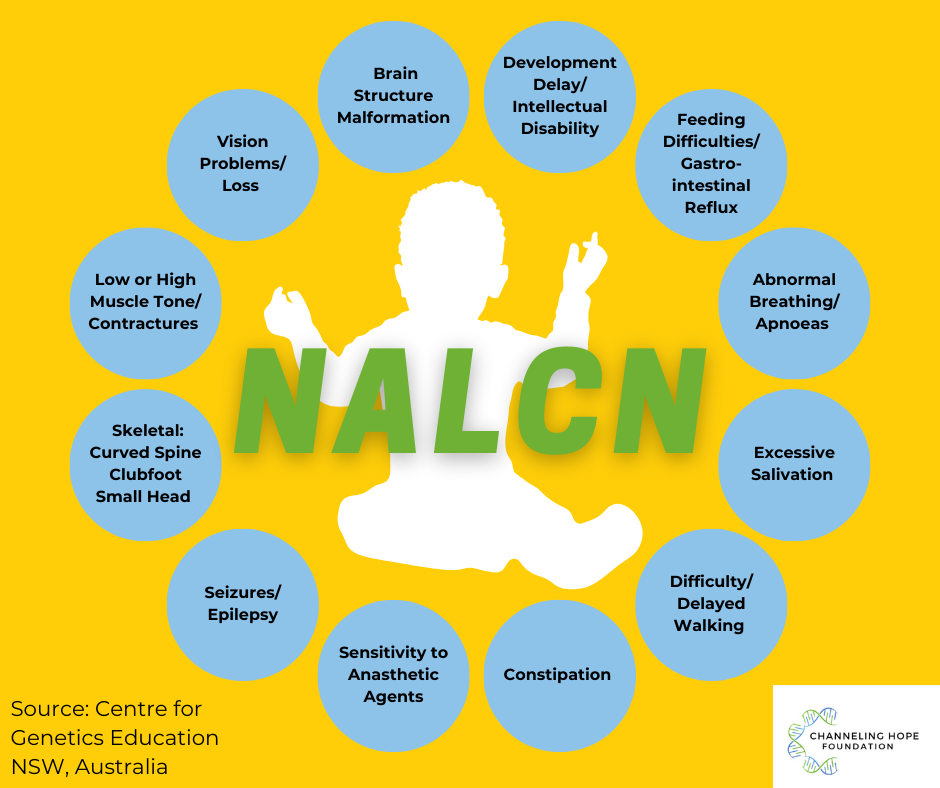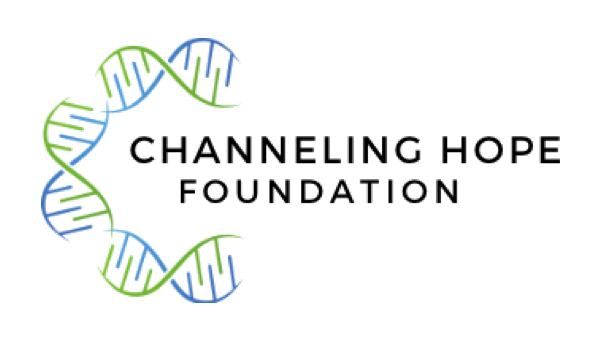The NALCN Channelosome

NALCN
NALCN ("Sodium Leak Channel") is a nonselective ion channel that plays a crucial role in regulating the healthy firing of neurons and other excitable cells in the body involved in rhythmic processes such as breathing and sleep. It is a distinct branch of the four-domain ion channel family that includes voltage-gated sodium and calcium channels. The NALCN channel is coded by the NALCN gene. This gene is conserved across many species, which means that the NALCN channel and gene can be studied in many different organisms.
The NALCN channel protein interacts with 3 other neuronal proteins (UNC79, UNC80, and FAM155A) to form the "NALCN Channelosome." This entire channel complex appears necessary for normal functioning of the ion channel and thus healthy neuron firing. Recent studies using cryo-electron microscopy have revealed the structure and assembly of this NALCN Channelosome, which is an important step towards identifying therapies.
Mutations in the NALCN gene and in the association proteins (UNC79, UNC80, FAM155A) affect the function of the NALCN Channelosome. Such mutations have been associated with a variety of severe child neurodevelopmental diseases. Dysfunction in the channel has also been implicated in widespread diseases including insomnia, cancer metastasis, endocrine disorders, and pain. Currently, there are no FDA-approved treatments for NALCN-related diseases.
Research into the NALCN gene and the NALCN Channelosome is ongoing and rapidly progressing as scientists continue to explore its structure and function. NALCN has thus far been shown to be a promising and feasible therapeutic target. Studies in animal models that use therapies to modulate NALCN function have shown improved symptoms, suggesting that such strategies can serve as a possible approach to treatment.
These studies and many others provide hope that our ultimate goal is within our scientific grasp - to discover therapies for children and families affected by NALCN-related diseases. We are excited to help support motivated scientists, clinicians, and families to take the next steps forward towards this goal.
Information about diseases caused by changes in the NALCN gene can be found in this Fact Sheet from the New South Wales Center for Genetics Education.
Ultra-rare Diseases
Ultra-rare diseases are often defined as a disease or condition that affects <200,000 people. While each individual disease is rare, ultra-rare diseases as a group are being increasingly recognized as a public health and medical priority. This is because ultra-rare diseases are:
(1) Common as a group - over 7000 rare diseases affect >30 million people in the US, and the numbers are increasing with advancements and access to genetic and other diagnostic testing
(2) Severe - many are life-threatening and/or debilitating, and have an enormous impact on patients and family - as do NALCN-related diseases
(3) Unmet need - most ultra-rare diseases, including NALCN-related diseases, lack approved therapies. There is often little incentive for pharmaceutical and other companies to support personalized therapy development given the small number of patients.
As a result, the NIH, FDA, and other organizations have taken extensive efforts to support ultra-rare diseases research and treatment development. Most therapy discovery and development efforts are led by ultra-rare disease organizations (such as CHF) and academic medical centers.
Additional information can be found through the National Organization for Rare Disorders: https://rarediseases.org/
CLIFAHDD
Congenital Contractures of the Limbs and Face, Hypotonia and Developmental Delay (CLIFAHDD; OMIM #616266) is a syndrome characterized by developmental and neurological symptoms, including global neurodevelopmental delay, joint abnormalities (contractures), low muscle tone (hypotonia), facial abnormalities, and sleep apnea. CLIFAHDD is caused by a single de novo autosomal dominant mutation in the NALCN gene (meaning that the mutations are randomly acquired and are not carried by parents) that is thought to cause a gain of function in the NALCN channel.
Key features:
- Global Neurodevelopmental Delay/Intellectual Disabilities: Individuals with CLIFAHDD experience developmental delays, particularly in terms of motor skills, speech, feeding, and cognitive abilities. The extent of the delay varies among affected individuals. Individuals with CLIFAHDD have intellectual disabilities, ranging from mild to moderate in severity.
- Joint Contractures and Abnormalities (“Arthrogryposis”): Individuals with CLIFAHDD may have various conditions affecting the joints. These may involve the upper extremities (such as ulnar deviation, thumb adduction, finger spacing) or lower extremities (such as clubfoot or hip dysplasia). These often require bracing and specialist orthopedic care for treatment, and may affect mobility and overall function.
- Hypotonia: Hypotonia refers to reduced muscle tone, leading to poor muscle strength. This can contribute to motor developmental delays and difficulties with mobility. In some children, there can be hypertonia·
- Abnormal Breathing and Sleep Apnea: The NALCN channel is involved in normal respiratory rhythms, and mutations affect these breathing patterns. Children affected by CLIFAHDD may have irregular breathing patterns, which may require oxygen and other forms of breathing support. Additionally, children may develop stopping of breathing, particularly during sleeping (sleep apnea).
- Facial Features: Distinct facial features can include a high forehead, arched eyebrows, a flat nasal bridge, a short nose, and a downturned mouth.
- Constipation: Many individuals will experience constipation, requiring treatment
- Other Neurologic Diseases: Individuals with CLIFAHDD are at increased risk for seizures, hyperkinetic movement disorders (such as dystonia, ataxia), and vision changes
- Excessive salivation: This can be treated with medications or injections (botox), if necessary
Management and research:
Management of CLIFAHDD typically involves a multidisciplinary approach, addressing the various medical, developmental, and educational needs of affected individuals. Therapies such as physical therapy, speech therapy, and occupational therapy may be recommended to improve motor skills and communication. Genetic counseling is also important for affected families to understand the underlying genetic cause and potential inheritance patterns.
As research continues to uncover more about the NALCN gene and its role in neurological development, there may be advancements in our understanding of CLIFAHDD and potential treatment strategies.
IHPRF 1 and 2
Infantile hypotonia with psychomotor retardation and characteristic facies-1 and 2 (IHPRF 1 - 615419 and IHPRF 2 - 616801) are severe autosomal recessive neurologic diseases thought to be due to a loss of function in the NALCN channel. Affected individuals show severe global developmental delay with poor or absent speech and absent or limited ability to walk. Some patients may have seizures that can be controlled.
In IHPRF-1, there is decreased electrical activity and not enough sodium reaches the cells. IHPRF-2 occurs when there is a loss of function in the UNC80 gene, which provides instructions to NALCN. UNC80 mutations impair the stability of the NALCN gene.
Key features:
- Hypotonia: Hypotonia refers to decreased muscle tone, which can lead to poor muscle strength and control. Infants with IHPRF1 often have floppy muscles, making it difficult for them to hold up their heads, sit, stand, or walk.
- Psychomotor Retardation: Children typically experience delays in achieving developmental milestones, such as rolling over, sitting, crawling, and walking. Intellectual and cognitive development is also usually delayed.
- Characteristic Facies: "Facies" refers to the facial features of an individual. Children may exhibit distinct facial characteristics, although these features can vary. These features may include a broad forehead, deep-set eyes, a flat nasal bridge, a wide and open mouth, and full cheeks.
- Seizures: Seizures are common. These seizures can be of various types, including generalized tonic-clonic seizures (formerly known as grand mal seizures) and absence seizures.
- Regression: Some children may experience a loss of previously acquired developmental skills, a phenomenon known as developmental regression. This can be particularly distressing for families as they witness their child's skills and abilities decline over time.
- Intellectual Disability: Children usually have varying degrees of intellectual disability, which can range from mild to severe.
Management and research:
Management strategies aim to address the symptoms and improve the individual's quality of life. This involves supportive care, physical and occupational therapy, and addressing any associated medical issues such as seizures.
Research into these genes and their associated diseases contributes to a better understanding of the molecular mechanisms underlying neurodevelopmental and neurological conditions.

Contact Us!
If you have any interest in joining our effort (in any capacity that you are able) or if you have any questions about the organization, please email us anytime at info@channelinghope.org.
